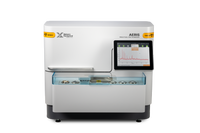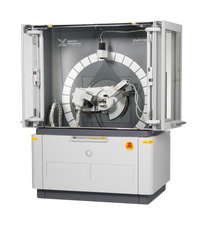X-ray analysis
X-ray analysis techniques using x-ray fluorescence and x-ray diffraction instruments

X-ray analysis techniques using x-ray fluorescence and x-ray diffraction instruments

In many production or R&D settings, x-rays can be used to characterize materials and samples. The x-ray wavelength range (from 0.01 to 10nm) make them exceptionally suitable to analyze structures and elements at the atomic level.
There are a few main techniques how X-rays can be used to help characterize your sample.
X-ray diffraction (XRD) and x-ray scattering can be used, for example, to analyze a samples’ crystal structure (X-ray crystallography) or to identify and quantify crystalline phases in a sample (X-ray powder diffraction / XRPD).
X-Ray diffractometers can also be extended with tools and accessories to visualize the internal structure an object, or use x-ray scattering to determine nanoparticle size distributions.
X-ray fluorescence (XRF) is a widely used non-destructive and fast technique to determine the elemental composition of a material requiring only minimal sample preparation.
XRF analyzers can be used for various applications, ranging from screening incoming goods for toxic elements to precise analysis in high-throughput, production-critical environments.
Malvern Panalytical has a range of XRF analyzers to meet your challenges.
XRD and XRF are complementary techniques with several similarities as both use an X-ray source and an X-ray detector, but the information provided by the two techniques is very different.
XRD provides information about the crystalline phases present in a sample, and can distinguish between compounds - for example different oxidation states (Fe2O3/Fe3O4) or between different polymorphs (hematite vs maghemite, both being ferric oxide Fe2O3).
XRF provides information about the chemical (elemental) composition of a sample, i.e. which element (Fe, O) are present and in which quantities. One of the main benefits of XRF is that it can detect the amount of a chemical element down to 100 ppb (part per billion). XRF sample preparation is also fast, easy and safe compared to alternative techniques.
Malvern Panalytical is a world-leading provider of X-ray analytical equipment with decades of experience.
We offer a wide range of solutions ranging from easy-to-use benchtop systems to full-power, comprehensive floor standing systems for both XRF and XRD.
These techniques are complimentary and in many production control environments both types of equipment are used to ensure optimal quality assurance.

AerisThe future is compact |

EmpyreanThe intelligent diffractometer |

ZetiumSmart Zetium for reliable results and robust operation |

Epsilon rangeFast and accurate at- and on-line elemental analysis |

Axios FASTXRF of choice for highest throughput or shortest measurement time |

Epsilon XflowDirect insight into your liquid process parameters |
|
|---|---|---|---|---|---|---|
| Technology | ||||||
| X-ray Diffraction (XRD) | ||||||
| X-ray Fluorescence (XRF) | ||||||
| Wavelength Dispersive X-ray Fluorescence (WDXRF) | ||||||
| Energy Dispersive X-ray Fluorescence (EDXRF) | ||||||